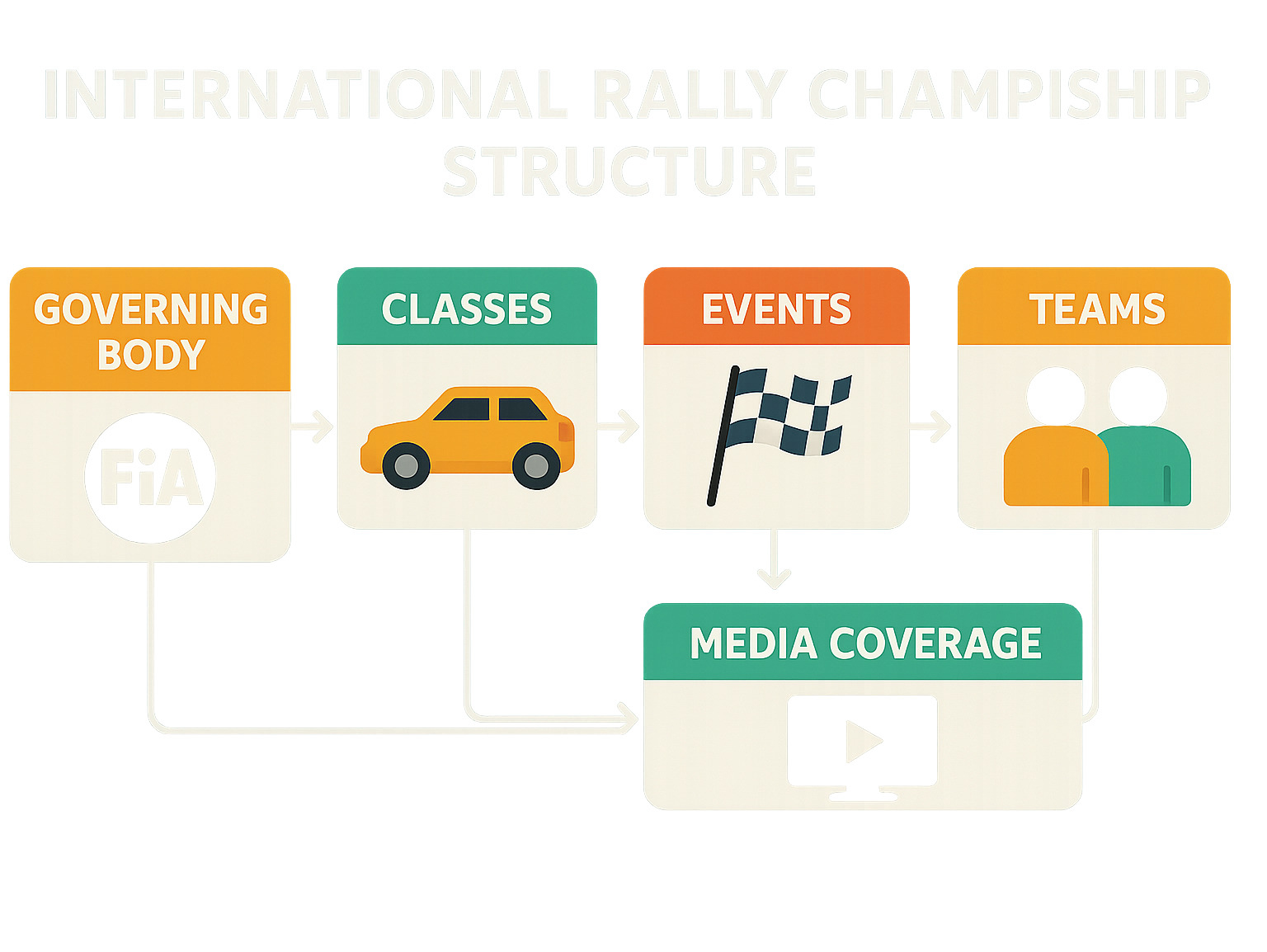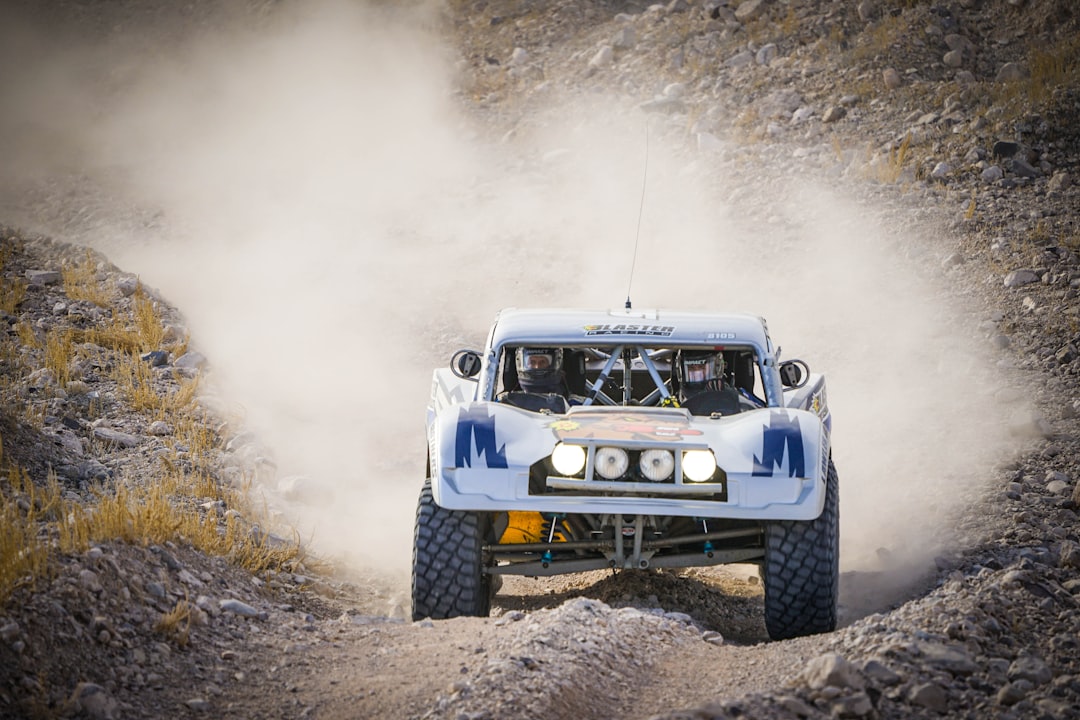International rally championship: 10 Powerful Reasons to Love 2025
The Global Spectacle of Rally Racing
International rally championship refers to a worldwide motorsport competition where drivers race modified production cars on varied surfaces including tarmac, gravel, snow, and dirt. These events test both speed and endurance across challenging terrain and changing weather conditions.
| Key Facts About International Rally Championships |
|---|
| 🏆 Main Series: FIA World Rally Championship (WRC) is the premier international rally series |
| 📅 Season Length: Typically features 13-14 events spread across multiple continents |
| 👥 Audience: Reaches a cumulative TV audience of 1.3 billion viewers annually |
| 🚗 Car Classes: Multiple categories from top-tier Rally1 hybrid cars to amateur classes |
| 🎮 Virtual Presence: Exists as both real-world competition and virtual/gaming series |
The International Rally Championship represents the pinnacle of rally racing, combining raw driving skill with strategic thinking and technical innovation. Unlike circuit racing, rally events take place on closed public roads where drivers steer from point to point at breakneck speeds guided by co-drivers reading detailed pace notes.
The championship has evolved significantly since its early days, changing from regional competitions into a global phenomenon that captivates millions. Modern international rally championships feature sophisticated cars, comprehensive media coverage, and passionate fan bases around the world.
Whether referring to the official FIA World Rally Championship, the historic Intercontinental Rally Challenge (2006-2012), virtual competitions in games like Gran Turismo, or the 1997 PC video game of the same name, international rally championships share common elements: challenging diverse terrain, modified production-based vehicles, and the fundamental test of driver and machine against the clock.

International rally championship terms to know:
– Iconic race car liveries
– Race car telemetry systems
– Racing simulator training
What Is the International Rally Championship?
The International Rally Championship isn’t just one thing—it’s a whole world of adrenaline-pumping motorsport competition that’s been thrilling fans since the 1990s. While many people immediately think of the FIA World Rally Championship (WRC) when they hear this term, it actually covers a much broader spectrum of rally competitions, from historical series like the Intercontinental Rally Challenge that ran from 2006 to 2012, to the virtual championships and even video games carrying the same exciting name.
What makes these championships so special? Unlike traditional circuit racing where drivers battle wheel-to-wheel, rally competitors race against the unforgiving clock, tackling closed-road special stages across everything from snow-covered forest paths to dusty desert trails. The “international” part comes from the truly global nature of these events—they span multiple continents, bringing together teams and drivers from around the world in a celebration of speed, skill, and endurance.
Today’s premier International Rally Championship, the WRC, has grown into a global phenomenon. In 2024 alone, it reached an incredible 1.3 billion television viewers worldwide while generating over 1.7 billion social media impressions. These mind-boggling numbers highlight why rally racing captures our imagination—it combines the relatability of seeing production-based cars with the jaw-dropping spectacle of watching them pushed to their absolute limits across nature’s most challenging landscapes.
You can learn more about the official IRC in its Wikipedia entry.
Early History & Evolution
The modern International Rally Championship has fascinating roots that stretch back to various European rally competitions that gradually evolved into the structured international series we know today. A key milestone in this journey was the creation of the Network Q RAC Rally, which eventually became an important piece of what would grow into today’s WRC.
The 1980s and early 1990s saw international rallying go through some dramatic changes. The infamous Group B era (1982-1986) featured insanely powerful, purpose-built machines that were eventually banned after several tragic fatal accidents. This led to the more production-based Group A era, which prioritized stricter safety regulations without sacrificing the excitement.
I love how 2019 World Rally Champion Ott Tänak perfectly captured the spirit of the International Rally Championship after one particularly dramatic win: “This is motorsport – sometimes it’s very hard, sometimes it’s amazing. It’s never perfect.” Anyone who’s followed rally knows this truth—entire championships can hinge on mere tenths of seconds, with triumph and heartbreak often separated by the smallest margins.
The evolution continued with the World Rally Car era beginning in 1997, allowing for greater technical creativity while maintaining safety standards. Most recently, in 2022, the WRC acceptd a more sustainable future by introducing Rally1 hybrid cars, combining traditional engines with electric power.
Throughout this journey, media coverage has been crucial to the championship’s growth. Eurosport’s innovative broadcasting brought the drama and spectacle of remote rally stages directly into living rooms worldwide, helping turn what was once a niche sport into a global phenomenon.
International Rally Championship video game legacy
Beyond the mud-splattered reality of actual competition, the International Rally Championship name belongs to an influential 1997 PC racing game developed by Magnetic Fields and published by Europress Software. This title holds a special place in rally gaming history as the fourth entry in Magnetic Fields’ respected series of rally simulations.
The game featured an impressive 16 tracks set in wildly diverse global locations—from Switzerland’s treacherous mountain passes to Egypt’s shifting sands, Indonesia’s dense jungle, and Russia’s arctic wilderness. Players could choose from nine rally-tuned cars including fan favorites like the Ford Escort, Mitsubishi Lancer, and Subaru Impreza.
What made this game stand out in 1997 was its multiplayer capability, supporting up to 8 players via LAN connections—pretty groundbreaking for its time! The included track editor was another forward-thinking feature, letting players create their own rally stages with custom parameters.
As one reviewer put it: “International Rally Championship is an excellent sequel to Magnetic Fields/Europess’ 1996 Rally Championship, and is the fourth entry in Magnetic Fields’ long line of top-notch rally simulations.” While it might not be as well-remembered as some later titles, this game introduced countless fans to the thrills and challenges of international rally competition.
You can learn more about this classic game at PCGamingWiki.
International Rally Championship online/virtual series
The International Rally Championship concept has found exciting new life in the digital field through online and virtual racing series. One of the most impressive examples is the community-organized championship run within the Gran Turismo gaming franchise.
What started in Gran Turismo 6 has evolved through five seasons on GT Sport before recently migrating to GT7. These virtual championships mirror the structure and regulations of real-world rallying while making them accessible to anyone with a gaming console. The 2025 season features 14 rounds, with each rally event lasting one week—just like the real-world championship format.
These virtual championships have grown incredibly sophisticated over time. They now feature comprehensive regulations covering everything from car classes and technical specifications to livery requirements and sporting conduct. The 2025 virtual IRC offers 12 distinct car classes, ranging from powerful Gr. B Rally Cars to more modest N100 Road Cars, plus an innovative new GLP regularity class.
As esports continue their meteoric rise, these virtual rally championships provide a perfect entry point for fans to experience the thrill of International Rally Championship competition without needing the enormous financial investment required for real-world participation. They also serve as valuable training grounds for aspiring rally drivers, offering a risk-free environment to learn tracks and hone techniques before potentially hitting the real dirt.
Sporting Rules & Regulations
The world of International Rally Championship racing isn’t just about fast cars and skilled drivers—it’s also governed by a fascinating set of rules that keep everything fair and safe. Think of these regulations as the invisible framework that allows the spectacular motorsport we love to function smoothly.
To join the party at top-tier international rallies, drivers need an FIA international license—essentially their passport to competition. Their rally machines must also pass strict technical checks specific to their class. It’s a bit like airport security for race cars, where every detail matters before you’re cleared for takeoff.
The rhythm of a rally weekend follows a familiar pattern that rally fans have come to love. Before engines roar in competition, crews drive the stages at reduced speeds during “recce” (reconnaissance) to create their all-important pace notes. Then comes the shakedown—a final chance to test setups under real conditions before the clock starts counting for real.
When the rally proper begins, it’s all about tackling special stages—those closed-road sections where drivers push to the absolute limit. Between these high-intensity bursts, teams can only work on their cars in designated service parks, often creating the fascinating spectacle of mechanics performing miracle repairs against the clock.
One of the most fan-friendly rules in modern rallying is the “restart after retirement” provision (previously called SuperRally or Rally2). This clever regulation keeps the show going by allowing crews who’ve had a bad day to rejoin the next morning with time penalties. As the WRC website puts it: “Restart-after-retirement rules add fixed time penalties plus the winning stage time in a priority group.” This means more cars on stages and more drama throughout the weekend!
Points System Breakdown
Scoring in the International Rally Championship rewards both consistency and those heart-stopping moments of brilliance. The WRC currently uses a 25-18-15-12-10-8-6-4-2-1 scale for the top ten finishers, creating battles throughout the field as every position matters.
The Power Stage—usually the rally’s final test—adds another layer of strategy with bonus points (5-4-3-2-1) for the five fastest drivers. This creates fascinating dilemmas: should a driver in a comfortable third place push hard for Power Stage points and risk everything, or bank the solid finish? These decisions often make for thrilling Sunday afternoon viewing.
Points are tracked separately for drivers, co-drivers, and manufacturers, with specific rules determining manufacturer standings. The 2025 WRC regulations note that “Only the highest finisher per manufacturer is eligible to score manufacturer points,” which explains why factory teams field multiple cars—they’re hedging their bets to maximize championship chances.
For 2025, the championship has tweaked the points system to put greater emphasis on outright rally wins rather than just consistent finishes. This subtle shift reflects the championship’s philosophy that speed and success should be the ultimate rewards.

Penalties & Dispute Resolution
The penalty system in International Rally Championship events works a bit like traffic laws for rally competitors. Time penalties—the most common sanction—can be handed out for arriving late at time controls, knocking over cones on super special stages, or getting unauthorized help. It’s all about keeping everyone playing by the same rules.
More serious infractions might result in exclusion or disqualification. Technical violations—especially when cars don’t match their homologation specs—can lead to the harshest penalties. After all, rally isn’t just about driving skill but also about technical compliance.
When disputes arise (and in competitive motorsport, they certainly do), there’s a clear path to resolution. Event stewards make initial decisions, but competitors can appeal to higher authorities within the governing body if they feel wronged. These appeals must follow strict procedures and timelines—rally may be exciting, but its governance is methodical.
Every International Rally Championship operates under a fair play code that goes beyond just the technical rules. Dangerous driving, verbal abuse, or actions that damage the sport’s reputation aren’t tolerated. As one virtual IRC rulebook plainly states: “Insults, racism or any other form of verbal abuse will result in a ban from the championship.” This emphasis on sportsmanship reminds us that while rally is competitive, respect remains at its heart.
The comprehensive regulations archive at JUWRA.com offers fascinating insights for those who want to dive deeper into how these rules have evolved over the years, showing how rally’s governing frameworks have adapted to changing times, technologies, and safety standards.
Car Classes & Technical Categories
When you dive into the International Rally Championship, you’ll find a fascinating variety of car classes that make this motorsport so exciting. From fire-breathing monsters to more modest machines, there’s something for every budget and skill level.
At the top of the pyramid sits the Rally1 category – the crown jewels of modern rallying. These hybrid beasts combine a punchy 1.6-liter turbo engine with a 100kW electric motor, delivering eye-watering performance while nodding to our more sustainable future. When you see these cars flying through forest stages, you’re witnessing the cutting edge of rally technology – and manufacturers investing millions to showcase their engineering prowess.
Step down a notch and you’ll find Rally2 cars (formerly known as R5) – still seriously quick four-wheel-drive machines but at roughly half the budget of their Rally1 cousins. These cars form the backbone of many regional championships and provide a more accessible entry point for professional teams.

The championship ladder continues with Rally3, Rally4, and Rally5 categories, each offering progressively more affordable ways to go rallying while maintaining that competitive thrill. These classes feature specific regulations on everything from engine size to permitted modifications, creating level playing fields within each category.
No discussion of rally classes would be complete without mentioning the legendary Group B cars of the 1980s. These “killer B’s” with their minimal restrictions and outrageous power outputs live on in rally folklore. While they’re now confined to demonstration runs and historic events, their wild spirit continues to influence how we think about rally cars today.
| Car Class | Drive System | Approximate Power | Typical Cost Range |
|---|---|---|---|
| Rally1 | 4WD + Hybrid | 500+ hp combined | $1M+ |
| Rally2/R5 | 4WD | 280-300 hp | $250-300K |
| Rally3 | 4WD | 215 hp | $150K |
| Rally4 | 2WD (FWD) | 210 hp | $80-100K |
| Rally5 | 2WD (FWD) | 130 hp | $50-70K |
| GLP | Various | Various | Entry-level |
GLP Class Explained
The GLP class (Gara di Leggibilità e Precisione) offers a refreshingly different approach to rallying that’s perfect for newcomers. Unlike traditional rallying where flat-out speed is everything, GLP rewards consistency and precision above all else.
Here’s how it works: drivers first set a “banker” lap to establish their target time. Then they complete subsequent runs trying to match that time as closely as possible. Your score is calculated based on how much you deviate from your target – the smallest total deviation wins. It’s like golf, where the lowest score takes the trophy!
“I was intimidated by rallying until I tried GLP,” shares one amateur competitor. “It let me focus on clean driving rather than taking risks I wasn’t comfortable with. Now I’m building skills that will help me move up the ladder.”
This regularity format has become particularly popular in virtual rally championships, where it provides an accessible competitive option that doesn’t require the same specialized equipment or setup knowledge as the performance-focused classes. It’s the perfect gateway into the International Rally Championship ecosystem.
Liveries & Branding Standards
The colorful, sponsor-plastered cars of the International Rally Championship aren’t just eye-catching – they follow specific rules ensuring both visibility and professionalism. Every competing car must display its competition number on standardized panels (typically doors and rear windows) so officials and fans can easily identify them.
Championship logos must appear in designated spots, usually on the windshield banner and front fenders. As one IRC rulebook plainly states: “Every car must display the IRC logo and a racing number to be eligible for points.” No logo, no glory!
While teams have creative freedom with their designs, certain restrictions apply. Tobacco advertising is prohibited across most international championships, and some events also restrict alcohol branding or other controversial sponsors. These rules align with broader sporting principles and respect local regulations in host countries.
For teams and their backers, creating a memorable livery is serious business. Think about the iconic race car liveries that have become part of rally heritage – Subaru’s blue and yellow, Lancia’s Martini stripes, or the psychedelic Ford Focus RS schemes. A great livery doesn’t just look good flying through the forest; it burns itself into fans’ memories and becomes part of motorsport culture.
The visual identity of rally cars extends beyond aesthetics – it’s where sport meets marketing in a high-octane partnership. When designed well, these rolling billboards create lasting impressions that transcend the championship itself, becoming symbols of an era in motorsport history.
Rally Event Structure & Calendar Highlights
The International Rally Championship season unfolds like a global trip story, with competitors chasing glory across 14 carefully selected rounds spanning Europe, Africa, and Oceania. This worldwide journey tests drivers and machines against every possible challenge Mother Nature can throw their way.
Each rally follows a familiar rhythm that fans come to anticipate. The drama begins with reconnaissance (“recce”) sessions, where driver and co-driver crawl through stages at reduced speeds, crafting the all-important pace notes that will guide them when racing flat-out later. Next comes the shakedown – essentially a competitive dress rehearsal where teams can fine-tune their setups before the real action begins.
When the rally properly kicks off, it’s divided into legs (usually matching up with calendar days), each packed with multiple special stages where the clock determines who’s smiling at day’s end. Between these high-speed tests, competitors become ordinary road users, navigating public highways under normal traffic laws during what insiders call “road sections.” Time controls ensure nobody dawdles or rushes between stages.
The beating heart of any rally is its service park – a busy hub of activity where fans can get surprisingly close to their heroes. Here, teams of mechanics perform what sometimes looks like magic, changing damaged rally cars back to fighting shape under the pressure of strict time limits. As one team principal put it: “In circuit racing, you perfect the car. In rallying, you frequently rebuild it between stages.”
Notable Global Events
The International Rally Championship calendar reads like a bucket list of motorsport’s most iconic challenges, each with its own distinct personality and demands.
Rallye Monte-Carlo stands as rallying royalty – the oldest and perhaps most prestigious event in the championship. Its treacherous alpine roads can switch from bone-dry asphalt to treacherous black ice within a single corner, making tire choice an agonizing gamble. Veterans speak of “Monte” with equal parts reverence and anxiety.
Safari Rally Kenya offers a completely different flavor of challenge. Here, rough roads, punishing heat, and the occasional wildlife encounter create what many consider the ultimate test of endurance. After winning the 2024 Safari Rally by three minutes, driver Gus Greensmith captured its essence perfectly: “The Safari is unlike any other rally—you’re not just racing against competitors but against the elements themselves.”
The championship’s winter wonderland arrives with Rally Sweden, where snow banks simultaneously punish mistakes and save cars from deeper trouble. The high-speed gravel roads of Finland feature the championship’s most spectacular jumps, while Greece’s Acropolis Rally beats cars into submission with rough, rocky mountain tracks – earning its nickname “Rally of Gods” for good reason.

How Weather & Surface Shape Strategy
In the International Rally Championship, Mother Nature isn’t just background scenery – she’s an active participant that shapes every strategic decision teams make. The weather and surface conditions transform rally competition from simple racing into complex environmental chess.
On gravel rallies, team engineers face delicious dilemmas: add suspension travel to absorb punishing impacts or keep the car low for better aerodynamics? Tire choices become equally critical – softer compounds grip better but wear quickly, while harder options sacrifice immediate performance for longevity. As one driver colorfully explained, “It’s like choosing between dancing shoes and hiking boots when you’re not sure if you’re going to a nightclub or climbing a mountain.”
Snow and ice events bring their own unique challenges. Studded tires become essential lifelines, with the number and arrangement of those tiny metal teeth making the difference between confidence and chaos. Early running order can be a curse on fresh snow, with first cars “cleaning” a faster line for those following behind.
Tarmac rallies trigger a complete change of the cars themselves. Teams lower ride heights, stiffen suspension, and fit larger brakes to maximize performance on smoother surfaces. But add rain to the equation, and suddenly tire choice becomes the million-dollar decision, with the timing of changes potentially deciding the entire rally.
The 2025 season marks a significant shift in the International Rally Championship landscape with Hankook becoming the exclusive tire provider for the WRC. This ends 52 years of open tire competition, but early reports suggest a smooth transition: “Hankook’s WRC debut earned widespread praise from teams and drivers,” indicating the Korean manufacturer has hit the ground running – or rather, sliding, jumping, and drifting.
For more insights into the technology that powers these incredible machines, check out our detailed look at innovative racing technology and find how rally cars have influenced the development of everyday vehicles.
Entering the Championship: From Sign-Up to Scrutineering
So you’re dreaming of kicking up dust in an International Rally Championship? I get it! There’s nothing quite like the thrill of rally racing, but before you can tackle those special stages, there’s a bit of paperwork and preparation to handle first.
The journey from rally enthusiast to competitor starts well before you hear “5-4-3-2-1-GO!” First comes the registration dance – filling out forms that detail everything about you, your co-driver, and that beautiful machine you’ll be piloting through forests and mountains.
For the top-tier competitions, you’ll need FIA International licenses for both driver and co-driver. These aren’t handed out like candy at a parade – you’ll need to prove your skills at lower-level events, pass medical checks, and complete safety training. Think of it as rally racing’s way of making sure you know what you’re getting yourself into!
Entry fees vary wildly depending on where you’re competing. Amateur events might set you back a few hundred dollars, while securing a spot at a WRC round could cost tens of thousands. As one team owner once told me with a wry smile, “In rallying, the entry fee is just your ticket to spend more money!”
Priority entry systems typically favor the big manufacturer teams and established competitors – they’re a bit like VIPs at an exclusive club. The remaining spots usually go to teams based on sporting merit or sometimes simply who clicked “submit” first on the registration portal.
The final hurdle before you can hit the stages is scrutineering – that nerve-wracking moment when technical officials inspect every inch of your pride and joy. They’re checking that your car complies with all the regulations for your class, from safety equipment to engine specs. I’ve seen grown adults biting their nails while officials measure roll cage thickness with calipers!
Technical Regulations Checklist
The rule books governing International Rally Championship cars could probably stop a bullet – they’re that thick and comprehensive! Understanding these regulations isn’t just important; it’s the difference between celebrating on the podium or watching from the sidelines after a disqualification.
Safety equipment sits at the top of every technical checklist. FIA-approved roll cages, racing seats, six-point harnesses, and fire suppression systems aren’t optional extras – they’re mandatory across all classes. Your personal gear needs to meet strict standards too, including helmets, HANS devices (those neck-saving collar things), and fire-resistant clothing that can withstand temperatures that would melt your smartphone.
For those competing in Rally1 cars (the big leagues!), the hybrid power units must follow exacting specifications. Since their introduction in 2022, these systems have represented rally’s step toward a more sustainable future while still delivering heart-stopping performance. The components come from designated manufacturers, so there’s no room for creative interpretation here.
Weight and dimension restrictions apply across all classes, with minimum weights carefully calculated to prevent teams from shaving off too much material and potentially compromising safety. I once watched a team frantically adding lead weights to their door panels just minutes before scrutineering – they’d gotten a bit too enthusiastic with their lightweight carbon fiber replacements!
Aerodynamic elements like rear wings and splitters are tightly controlled too. You can’t just show up with a wing the size of a picnic table and expect to pass inspection, no matter how cool it might look on Instagram.
Electronic systems represent another heavily regulated area. The rules around sensors, data acquisition, and driver aids vary by championship level, but they’re all designed to keep competition fair and costs somewhat under control. Modern telemetry systems allow teams to monitor everything from engine temperatures to driver inputs, though the permitted data collection varies by class.

Cost & Logistics Essentials
Let’s talk money and movement – two things you’ll need plenty of to compete in an International Rally Championship!
The financial reality of rally racing might make your wallet whimper. Entry fees are just the appetizer in a very expensive meal. For the cream of the crop WRC teams, annual budgets can sail past $10 million, covering everything from car development to the complex logistics of global competition. Even privateers competing in lower classes typically need several hundred thousand dollars to fund a season. As they say in rally circles, “How do you make a small fortune in rallying? Start with a large one!”
The logistical puzzle of moving cars, parts, and people around the world is mind-boggling. When one event ends in the snowy forests of Sweden and the next starts on the dusty plains of Kenya just weeks later, teams become masters of transportation planning. Sea freight for heavy equipment, air cargo for urgent parts, and road transportation for everything in between – it’s a complex choreography that would make professional movers sweat.
Your service crew is the beating heart of your rally operation. These unsung heroes work miracles during service breaks, sometimes completely rebuilding half a car in the 30-minute service window. Teams typically deploy specialists for different aspects – engine wizards, suspension gurus, tire whisperers, and body repair magicians who can make a crumpled fender look showroom-fresh with just a rubber mallet and determination.
“The racing is just the visible tip of the iceberg,” one veteran team manager told me while his crew worked frantically to replace a gearbox between stages. “Beneath that is a mountain of planning, preparation, and problem-solving that makes those competitive moments possible.”
For anyone looking to dip their toes into rally competition, start small and local before setting your sights on international events. The learning curve isn’t just about driving fast – it’s about building the infrastructure and knowledge to compete effectively at higher levels. Check out resources like Innovative Racing Technology and Race Car Telemetry Systems to better understand the technical side of the sport.
In rallying, preparation isn’t just about being competitive – it’s about being safe to race another day!
Tips for New Drivers & Teams
Breaking into the International Rally Championship scene might seem daunting, but with the right approach, it’s an incredibly rewarding journey. Whether you’re dreaming of WRC glory or simply want to enjoy grassroots competition, I’ve gathered some essential tips that apply across all levels of rally racing.
First and foremost, mastering pace notes is perhaps the most crucial skill you’ll need to develop. These detailed descriptions of the road ahead aren’t just random numbers and directions – they’re the lifeline between driver and co-driver that allows you to commit to corners you can’t yet see. The magic happens when both crew members develop a rhythm and shorthand that works specifically for them. Don’t get discouraged if this takes time – even the pros spend years refining their communication systems.
Tire strategy often separates the winners from the rest of the pack, especially in rallies with changing conditions. I’ve seen countless events where a smart tire choice made all the difference! Understanding how different compounds perform across various surfaces and temperatures – and making the right choices with your limited allocation – can give you a significant edge over competitors who might have faster raw pace.
“The right tire at the right time can make you look like a hero,” as rally legend Colin McRae once said. “The wrong one can make you look like a complete novice.”
Simulator training has revolutionized how new drivers prepare for competition. Modern racing simulators provide remarkably accurate physics models that translate surprisingly well to real-world driving. They’re particularly valuable for developing fundamental techniques and stage familiarity without the costs and risks of physical testing. Many current WRC drivers credit their simulator practice with helping them learn new stages quickly.
For those serious about a rally career path, establish a clear progression through the classes. Start in more affordable categories like Rally5 or national championships to build experience before attempting international competition. This stepped approach allows you to develop skills while building a portfolio that can attract sponsors and team opportunities.
As one veteran team manager told me: “I’d rather see a driver dominate at a lower level than struggle in a class they’re not ready for. Confidence builds skill, and skill attracts opportunity.”
Building Experience Through Virtual IRC
The virtual International Rally Championship world offers an incredible pathway for building experience that transfers surprisingly well to real-world rallying. These online competitions, especially those run through platforms like Gran Turismo, provide structured environments where you can develop racing techniques, strategic thinking, and competitive mindset without the massive financial investment of physical rallying.
Time trial practice forms the foundation of rally skill development. Virtual environments let you repeat stages endlessly, helping you internalize racing lines, braking points, and corner sequences until they become second nature. The ability to instantly restart after mistakes makes this learning process much more efficient than real-world practice.
Many games feature track editors that allow you to create or modify stages, giving you the power to design specific training scenarios focused on particular skills or challenges. “The track editor is easy to use yet powerful enough to create or recreate favorite tracks with custom parameters,” noted one reviewer. This lets you focus practice on your weaknesses, whether it’s hairpin turns, high-speed sections, or particular surface types.
Community events in the virtual rally world often mirror real championship structures and regulations, providing valuable experience with competition formats, rules, and procedures. These events help develop the mental approach needed for successful rallying – focus under pressure, adaptability to changing conditions, and performance management across a multi-day event.
What’s particularly fascinating is how well these skills transfer to real-world competition. From pace note timing to weight transfer management, virtual rally experience creates a foundation that many drivers have successfully built upon when they transition to physical cars.
Funding & Sponsorship Basics
Let’s be honest – securing adequate funding is often the biggest hurdle for aspiring International Rally Championship competitors. Even at entry levels, rallying isn’t cheap, which makes developing a comprehensive budget and funding strategy essential before you commit to a competition program.
Budget planning must account for all aspects of your operation. Create detailed spreadsheets covering car purchase or rental, preparation and maintenance, entry fees, transportation, crew expenses, and always include a generous contingency fund for repairs. One experienced privateer team manager shared: “Whatever you think you’ll need for repairs, double it – then you might be close.”
When approaching potential sponsors, demonstrating value goes far beyond simply asking for money. Create professional presentation materials highlighting audience demographics, media coverage, and brand alignment opportunities. Companies want to know exactly what they’ll get in return for their investment in your program.
Media engagement amplifies sponsor value tremendously by increasing visibility beyond event attendance. Maintain active, engaging social media accounts that showcase your journey, develop relationships with motorsport journalists, and create compelling content around your rally program. A strong social media presence can make a smaller team more attractive to sponsors than larger teams with poor media strategies.
“Treat finding sponsors with the same professionalism and dedication you bring to your driving,” advised one successful rally driver. “It’s not just about asking for money—it’s about creating genuine partnerships where both sides win.”
Smaller, local sponsors are often easier to secure when you’re starting out. The local garage, parts supplier, or even restaurants might be willing to provide modest support that can help you get to those first few events. Build a track record of delivering value, and larger sponsors will take notice.
For more insights on building a successful racing career, check out our guide on the Race Car Driver Career Path that walks you through the progression from amateur to professional.
Following the Action: Media, Stats & Fan Engagement
The world of International Rally Championship has never been more accessible to fans. Gone are the days when rally enthusiasts had to wait for delayed television highlights or next-day newspapers to find out what happened on those remote forest stages. Today’s digital landscape offers a smorgasbord of ways to follow every sliding, jumping moment of rally action.
WRC+ All Live has revolutionized how we experience rallying, bringing comprehensive live coverage of every stage directly to our screens. Imagine sitting at home with a cup of coffee while watching cars tackle the snowy forests of Sweden or the dusty tracks of Kenya in real-time. With multiple camera angles, in-car footage that puts you right in the co-driver’s seat, and insightful commentary from rally experts, the remote becomes accessible and immediate.
“The introduction of All Live in 2018 transformed rally spectating forever,” notes veteran commentator Colin Clark. “Fans can now experience every kilometer of every stage as it happens.”
Social media has become the beating heart of rally community engagement, with the WRC alone generating a staggering 1.7 billion social media impressions in 2024. These platforms serve up a constant stream of content that goes beyond just the competitive action. Through official championship accounts, you’ll find immediate results and highlight clips, while team and driver profiles offer those precious behind-the-scenes moments – the human stories that make rallying so relatable.
For the data-hungry fan, timing apps have become essential companions to the viewing experience. These digital tools let you track stage times, position changes, and overall standings in real-time, adding layers of understanding to what you’re watching. There’s something uniquely satisfying about seeing those time gaps visualized, especially when tenths of seconds separate competitors after hundreds of kilometers of racing.

Where to Find Results & Standings
When it comes to tracking International Rally Championship results and standings, several trusted sources offer everything from basic information to deep statistical dives.
The official WRC website and mobile app provide the gold standard for current and recent seasons’ information. Here you’ll find not just the bare-bones stage times and championship standings, but also fascinating statistical breakdowns that reveal patterns and trends throughout the season. These official platforms carry the authority that comes with being directly connected to the championship.
For the rally fan who wants broader coverage across multiple series, eWRC-results.com has become something of a holy grail. This independent site maintains extensive databases covering international, regional, and national championships alike. What makes it particularly valuable is its historical depth – want to know who finished third on the 1986 RAC Rally? This is where you’ll find it.
Specialized rally media outlets like Rally.TV add crucial context around the raw numbers. Their experienced journalists and former competitors offer insights that help you understand why a driver lost time on a particular stage or how weather conditions affected the overall results. These stories behind the statistics transform mere numbers into compelling narratives.
For followers of virtual championships, results typically appear on dedicated websites or social media groups specific to each competition. The Gran Turismo-based IRC series, for example, publishes comprehensive results alongside replay files and onboard videos, allowing virtual competitors to study and improve their techniques.
Collecting Data & Memorabilia
For the dedicated International Rally Championship enthusiast, the passion extends beyond just watching events. Collecting memorabilia and analyzing performance data offers a deeper connection to the sport’s rich heritage and technical complexity.
Stage time analysis becomes almost addictive once you start digging into the numbers. By comparing sector times between drivers, you’ll find fascinating patterns – how some drivers excel in flowing sections while others gain time in technical parts, or how different car setups yield advantages in specific conditions. These insights transform how you watch rallying, giving you a more nuanced appreciation of the skills on display.
Die-cast models represent perhaps the most popular tangible connection to rally history. From affordable mass-produced replicas to limited-edition pieces with remarkable detail, these miniature rally cars let fans hold a piece of motorsport history in their hands. The iconic Lancia Stratos, Audi Quattro, or modern WRC machines can all take pride of place on your shelf, each telling its own story of rally evolution.
“My first rally model was a 1:43 Subaru Impreza in the classic blue and yellow livery,” shares longtime collector Martin Wilkinson. “Twenty years later, I have over 200 models, each representing a moment in rally history that captured my imagination.”
Event programs, media guides, and results books offer fascinating historical snapshots that often contain information and images not readily available online. For researchers and rally historians, these printed materials provide valuable primary sources documenting the sport’s development. A service park pass from a memorable rally becomes not just a souvenir but a physical connection to an experience that meant something special.
The beauty of following the International Rally Championship today lies in this blend of immediate digital access and tangible connections to the sport’s heritage. Whether you’re watching live stages on your phone while tracking timing data on your laptop, or carefully adding another die-cast model to your collection, the rally experience has never been richer or more accessible.
For more rally coverage and automotive insights, be sure to check out our Auto Racing News section, where we regularly feature the latest from the International Rally Championship and other motorsport series.
Frequently Asked Questions about the International Rally Championship
How does the GLP scoring differ from traditional timing?
If you’re new to the rally world, you might be wondering about this unique GLP class that keeps popping up. Unlike traditional rally racing where it’s all about being the fastest, GLP (Gara di Leggibilità e Precisione) is all about consistency and precision.
In traditional rallying, drivers push to set the fastest possible time. But in GLP, you first set what’s called a “banker” time during your first run. Then, on your subsequent runs, your goal isn’t to go faster – it’s to match that initial time as closely as possible.
Your final score comes from how much you deviate from your banker time. The smallest total deviation wins! It’s a bit like golf – lower numbers are better.
“I love GLP because it teaches you the fundamentals of consistent driving,” explains one regular competitor. “You can’t just floor it and hope for the best. You need to hit your marks exactly the same way every time.”
This format is particularly welcoming for newcomers since it removes the pressure to take risks for outright speed. Instead, you can focus on developing precise driving skills at a pace you’re comfortable with. It’s rallying with a different kind of challenge!
What licences and safety gear are mandatory for entry?
Safety is paramount in the International Rally Championship, and this is reflected in the comprehensive requirements for both licensing and personal protection equipment.
For top-tier international events like WRC rounds, both drivers and co-drivers need FIA International competition licenses. These aren’t handed out easily – you’ll need proven experience, medical certification, and completion of specific safety training programs. Think of it as a professional certification for rally drivers.
Lower-level international events might accept national licenses with international extensions, while regional championships typically work with licenses from your country’s motorsport authority.
As for safety gear, the International Rally Championship takes no chances. Every competitor needs:
- FIA-approved helmets (compatible with head restraint systems)
- HANS (Head And Neck Support) devices
- Fire-resistant racing suits, underwear, gloves, shoes, and balaclavas
- FIA-approved seats and harnesses
- Emergency equipment including belt cutters
“The safety equipment might seem excessive until you’ve seen a serious rally crash,” notes one veteran driver. “Then you realize every piece of gear has a purpose – and might save your life.”
The good news is that while this gear represents a significant investment, most items have multi-year certification periods, allowing you to spread the cost over several seasons of competition.
Can one car compete in multiple classes during a season?
Yes, you can definitely enter your rally car in different classes throughout an International Rally Championship season – with some important caveats.
Most championships allow you to switch classes between events, provided your car meets all the technical requirements for each class you enter. This gives teams flexibility to experiment with different competitive approaches or respond to changing championship situations.
However, there’s one firm rule that nearly all rallies enforce: “You may only use one car per round.” This means once you’ve started an event in a particular vehicle and class, you’re committed until that rally’s conclusion. This rule keeps competition fair and makes technical inspections more manageable.
When considering class changes, manufacturer championship points have specific eligibility rules. Typically, only the highest-finishing car from each manufacturer scores points toward the manufacturer’s championship. This means factory-backed teams need to carefully strategize their class entries to maximize their championship prospects.
The practical challenge of changing classes is ensuring your car complies with all technical regulations for the new category. This might require modifications between events – anything from simple adjustments to significant rebuilds, depending on how different the class requirements are.
“We switched from Rally2 to the open class mid-season last year,” shares one team manager. “It gave us more freedom with the car setup, but meant completely reconfiguring the suspension and electronics between rallies. Worth it for the results, but definitely created some late nights for our mechanics!”
Conclusion
The International Rally Championship truly embodies motorsport at its most raw and thrilling form. There’s something magical about watching skilled drivers steer treacherous terrain at breakneck speeds – from sliding through Sweden’s snow-laden forests to bouncing over Greece’s rocky mountain passes. This championship tests not just driving ability, but a unique blend of technical skill, strategic thinking, and pure courage that few other sports demand.
What I’ve always loved about the International Rally Championship is how it manages to be both exclusive and accessible at the same time. Yes, the premier WRC series features those factory teams with eye-watering budgets, but the beauty lies in the pyramid structure beneath it. Grassroots international competitions welcome talented amateurs, while virtual championships open doors for simulator racers to test their skills without the financial barriers of real-world racing.
The sport continues to evolve in exciting ways. The introduction of hybrid technology at the top level shows rallying’s commitment to staying relevant in a changing automotive landscape. Meanwhile, both physical and virtual rally competitions are seeing growing global interest, bringing new fans and participants into this passionate community.
At its heart, though, the fundamental challenge remains beautifully unchanged – that unique partnership between driver and co-driver, working in perfect harmony as they tackle roads at the absolute limit of what’s humanly possible. There’s a purity to that challenge that transcends technological changes.
Whether you’re just finding rally through highlight clips, dedicated enough to follow every stage live through WRC+ All Live, or even planning your own competitive journey through the ranks, the International Rally Championship offers something special. Those production-based cars sliding through natural environments creates a spectacle that circuit racing simply can’t match – which explains why it continues to captivate millions around the world.
For more insights into motorsport and automotive culture, explore our other articles at Car News 4 You. We’re constantly updating our auto racing news section and covering emerging racing trends to keep you connected to the sports and vehicles you love.







